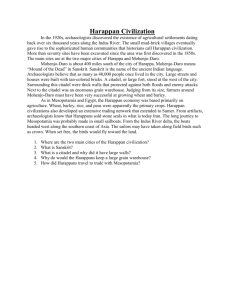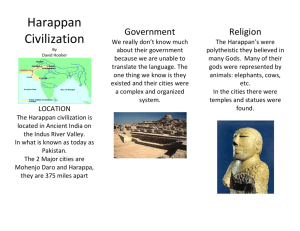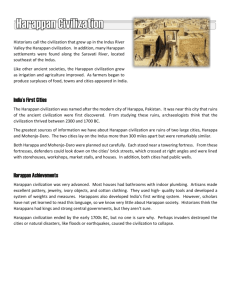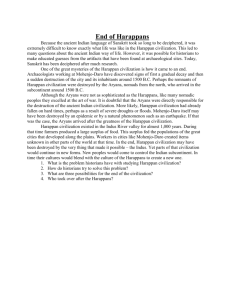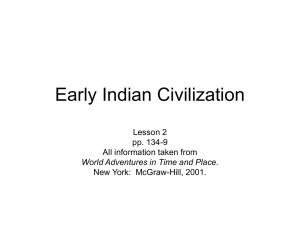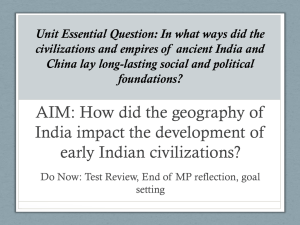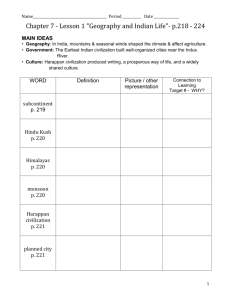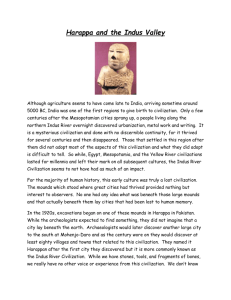Harappan Culture
advertisement
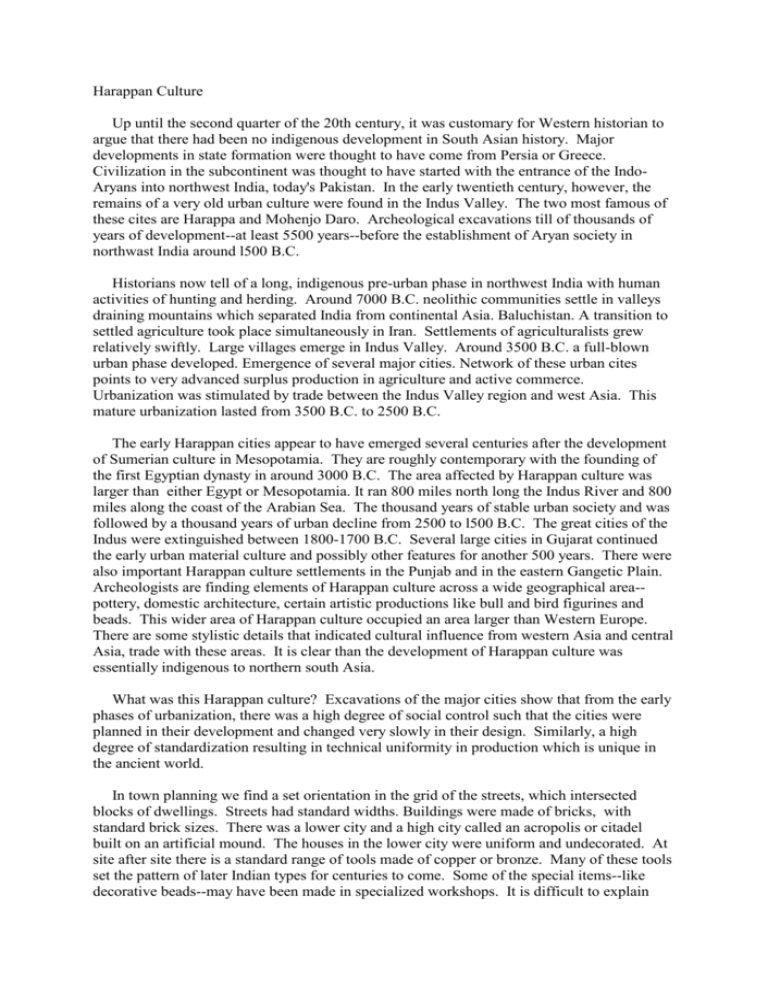
Harappan Culture Up until the second quarter of the 20th century, it was customary for Western historian to argue that there had been no indigenous development in South Asian history. Major developments in state formation were thought to have come from Persia or Greece. Civilization in the subcontinent was thought to have started with the entrance of the IndoAryans into northwest India, today's Pakistan. In the early twentieth century, however, the remains of a very old urban culture were found in the Indus Valley. The two most famous of these cites are Harappa and Mohenjo Daro. Archeological excavations till of thousands of years of development--at least 5500 years--before the establishment of Aryan society in northwast India around l500 B.C. Historians now tell of a long, indigenous pre-urban phase in northwest India with human activities of hunting and herding. Around 7000 B.C. neolithic communities settle in valleys draining mountains which separated India from continental Asia. Baluchistan. A transition to settled agriculture took place simultaneously in Iran. Settlements of agriculturalists grew relatively swiftly. Large villages emerge in Indus Valley. Around 3500 B.C. a full-blown urban phase developed. Emergence of several major cities. Network of these urban cites points to very advanced surplus production in agriculture and active commerce. Urbanization was stimulated by trade between the Indus Valley region and west Asia. This mature urbanization lasted from 3500 B.C. to 2500 B.C. The early Harappan cities appear to have emerged several centuries after the development of Sumerian culture in Mesopotamia. They are roughly contemporary with the founding of the first Egyptian dynasty in around 3000 B.C. The area affected by Harappan culture was larger than either Egypt or Mesopotamia. It ran 800 miles north long the Indus River and 800 miles along the coast of the Arabian Sea. The thousand years of stable urban society and was followed by a thousand years of urban decline from 2500 to l500 B.C. The great cities of the Indus were extinguished between 1800-1700 B.C. Several large cities in Gujarat continued the early urban material culture and possibly other features for another 500 years. There were also important Harappan culture settlements in the Punjab and in the eastern Gangetic Plain. Archeologists are finding elements of Harappan culture across a wide geographical area-pottery, domestic architecture, certain artistic productions like bull and bird figurines and beads. This wider area of Harappan culture occupied an area larger than Western Europe. There are some stylistic details that indicated cultural influence from western Asia and central Asia, trade with these areas. It is clear than the development of Harappan culture was essentially indigenous to northern south Asia. What was this Harappan culture? Excavations of the major cities show that from the early phases of urbanization, there was a high degree of social control such that the cities were planned in their development and changed very slowly in their design. Similarly, a high degree of standardization resulting in technical uniformity in production which is unique in the ancient world. In town planning we find a set orientation in the grid of the streets, which intersected blocks of dwellings. Streets had standard widths. Buildings were made of bricks, with standard brick sizes. There was a lower city and a high city called an acropolis or citadel built on an artificial mound. The houses in the lower city were uniform and undecorated. At site after site there is a standard range of tools made of copper or bronze. Many of these tools set the pattern of later Indian types for centuries to come. Some of the special items--like decorative beads--may have been made in specialized workshops. It is difficult to explain why one also finds uniformity in forms and painted decorations in pottery, because pots were made locally. We cannot not be too surprised, then, to discover that there was uniformity in weights and measures. Both Harappa and Mohenjo-Daro were built with an acropolis and a lower city. Each of these major sections was fortified. The acropolis was built to the west of the city and raised on an artificial mound of bricks. It contained large assemply halls and edifices for religious cults. Mohenjo-Daro was politically the most important city. Its acropolis had a Great Bath at the center which was used for ritual purposes. The Great Bath a tank sunk into the floor of an open courtyard. There were steps leading down to the tank at each end. There were special rooms for private bathing in an adjacent building. To the east was a building which was either the palace of a king or the residence of a high priest. On the acropolis there was an impressive grainery which had been well-veltilated and which was filled from outside the acropolis. At its largest, Mohenjo-Daro probably had 40,000 inhabitants. The Great Bath brings us to important aspect of Harappan culture: the unique feature of elaborate bathing and drainage facilities. In both the lower cities and the acropolises. Each residence or dwelling group was provided with a well and a bathing room or a bathing floor with provision for draining. There were built-in latrines, some even with seats. The waste flowed through chutes into an extensive system of enclosed brick drains built into otherwise unpaved streets. There is a major problem in trying to discover the non-material culture of Harappa civilization. This problem is that scholars have not been able to decifer the examples of writing which exist. It is has recently been argued that the signs which appear on seals do not constitute a system of writing, but of identification. These signs are found on seals used in trade, which are more than two and a half inches square. They are of superb craftmanship. These seals have short sets of signs which may have indicated the names of the person concerned. They were made in soapstone or sealtite, incised and fired, and decorated with scenes of cultural and religious nature. So the records of signs are not useful in telling us about the political structure of the area. It does seem, from archeological evidence, that Mohenjo-Daro was the capital of an imperial domain, a Harappan empire, the first empire in South Asia. Archeologists can trace the growing influence of Mohenjo-Daro by the changes in the pottery designs which they find in smaller settlements. Harappa and Kalibangan in the Punjab were probably minor centers in this empire and may have enjoyed regional autonomy. This first empire probably emerged around 2100 B.C. in a phase of rapid expansion and uniform construction It is possible even that Mohenjo-Daro was the capital for only a short time. Reason why it is doubtful that an empire lasted for a long is that while there are fortifications for defense, there are no signs of the maintenance of large military establishments. Harappan culture, then, was not a militaristic imperial culture, like that of the Roman Empire. The society of the major cities, however, was highly regulated and control. Archeological excavations have shown planning and control even at the lowest levels of Harappa and Mohenjo-Daro. There was no random growth as one usually finds in other areas of both west and south Asia. The main features of urban society were preserved for about 1000 years. One finds this evidence of social control in the widespread standarization in architecture and tool production. One also finds it in the rebuilding of buildings and road after floods. It is striking, however, that the surplus wealth of the Harappan society appears to have been invested for the public good--it was not assigned to the erection of huge and expensive monuments dedicated to a royal cult. We will find later in late Vedic society that Buddhism and Jainism will develop partly as a reaction against the lavish sacrifices of the Vedic rajas and their Brahman priests. Perhaps because of the absence of a marked royal cult, scholars have decided that a common sculpture found at Mohenjo-Daro is that of as priest or possibly a diety. The way the eyes are represented--as though concentrated on the tip of the nose indicate a well-known method of yoga. The placing of the robe over the left shoulder in one famous example shows up as a motief in Buddhist iconography. It appears from the different sizes of dwellings that there was an elaborate division of labor in the large cities. And scholars are tempted to suggest that the preoccupation which the drains and bathing arrangements indicate has much to do with cultic or religious interest. This suggests that the Harappans had a powerful sense of purity and pollution and the notion that water could be used to lesson pollution. These notions of pollution may have been connected to conceptions of social status. This is a major point to consider, because as we will discuss in connection with the development of the caste system, notions of purity and pollution tied to social status are of major importance in South Asian culture. It appears that Harappan culture, then, in this, as in several other ways, represents important values in the indigenous culture of South Asian which would combine with the cultural concepts of the Aryans to produce the characteristic features of, particularly, Hindu society in South Asia. This we find out from an examination of Harappan art. We find several elements which distinguish the Harappans out from the Vedic Age people which follow from about l500 B.D. There are indications of aspects of Harappan culture which gradually make an impact, as I mentioned above, on the general development of Indian society. It is not Harappan culture proper, itself--but culture traits which we might say that these people shared in a general way with the peoples of the subcontinent--often refered as Dravidians. Harappan culture people were interested in animals as the representation of natural powers which had divine aspects. Power may have been for them a divine force which was imminant in natural phenomena. Trees, for example, were sacred to them. The Aryans, on the other hand, worshipped transcendant gods which they divided into three categories--sky, atmosphere and earth gods. These gods were mostly male and had humanlike personalities. The Aryans appear not to have made images of their gods. The Harappans were interested in male animals only. But there appears to have been a vigorous popular culture which was preoccupied with the mother goddess, because countless little clay figurines of women are found at the sites. On the seals there are horned female figures in trees which can be interpreted as the yakshi, the fertility and tree-spirit, which comes to figure prominently in later Buddhist art. The art historian Benjamin Rowland points out that the little clay mother goddesses characteristically have a harness of scarves crossing between the breasts--this moteif survives in the decoration of the Buddhist yakshis. It seems certain that this design, as well as the beaded apron worn by some of that statuetts, was a fertility symbol since both are found in representations of the mother goddess from Mesopotamia and Iran. The Aryans worshipped male gods, but, as we shall see, they eventually incorporated into their religion a figure which one finds on the Harappan seals--an ascetic with three heads who is also, perhaps, a lord of the animals. This ascetic clearly represents maleness and, in fact, at Harappan sites one finds lingams, images of phalluses, which point to the overwhelming importance of maleness and male fertility to the Harappans. The ascetic would join with a Vedic god to emerge as the Hindu god Siva and the lingam would become one of the most familiar symbols in Hindu worship. The Harappan association of their ascetic with male animals--particularly with bulls--is reflected in the great bull, Nandi, which becomes the vehicle which Siva rides. The asceticism of Shiva, too, appears to reflect an indigenous element in South Asian religious--we mentioned the possibility that the bearded heads found in Mohenjo-Daro sculpture are meditating. One finds signs of an important concept from Hindu meditation in the technics of sculpture of a famous torso from Harappa. Art historians argue that the plasticity of the figure suggests the presence of the breath or prana which fills and expands the body of a yogi. The figure indicates the representations of an ascetics breathcontrol. We find another major influence from Harappan culture in the eventual substitution of puja, the worship of a god represented in the form of an image, for sacrifice as the central ritual in Hindu worship. In the Vedic period worship was dominated by a sacrifice, a yajna, with praise and prayer to non-anthropomorphic dieties (dieties without human form). Harappan culture may, then, have lived on, but what happened to the big cities and towns? Many years in to the 20th century, Aryans thought to have destroyed all of the Indus civilization. Skeletons in Mohenjo-Daro indicated a last massacre. But since the mid-20th century, new evidence indicates environmental factors. One suggestion is that destruction of the soil of the hinterland took place through the destruction of forests for use in firing the clay for bricks in the buildings and drainage works. Other evidence points to rivers--shifting in their paths; tectonic changes may have thrown up a dam in the lower Indus Valley causing the inundation of the plains. There is speculation as to the possibility of climatic changes, the decline in rain after 2500 B.C. It seems possible that one reasons for the spread of the Harappan culture is that there was continual forced evacution, sending people east to the eastern Gangetic Plain and south into Gujarat. The fighting, nomadic Aryans did come into northwest India at about the time of the final decline of urban centers and perhaps there were some military engagements. But what seems most likely is that, because these major urban bases had disintegrated, it was all the easier for the Aryan tribes to establish themselves politically over the villages of agricultural settlement of the native peoples of northwestern India and the Gangetic plain.

